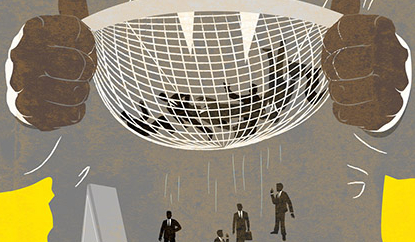Facing Business Challenges at Levi Strauss Can a company be socially responsible and successful? Levi Strauss & Company chairman and chief executive officer Bob Hass had some problems on his hands. After taking over leadership of the world-famous blue-jeans maker in 1984, Haas had worked hard to revitalize the company’s long-standing commitment to ethical and socially responsible behavior. However, changes in consumer tastes and stiff competition from rival clothing manufacturers were hitting the company hard on all sides. In order to remain competitive, Hass would have to make some tough decisions that could threaten the company’s principles. The original Mr. Levi Strauss had a simple business mission—make and sell quality work pants for San Francisco’s gold-rush miners. However, Strauss also demonstrated a strong social conscience and commitment to employees early on. During the Great Depression , workers were paid to lay a new floor in the factory until business picked up. By the 1960s, the company had become a vocal advocate for racial integration and a leader in corporate diversity programs. However, by the time Bob Haas (great-great-grand-nephew of Levi Strauss) took over in 1984, the company seemed to have lost its social conscience. Levi’s had expanded aggressively into product lines that were ultimately unprofitable. The company was bloated , profits were falling, and management was more concerned with numbers than with values. Haas believed that public shareholders and stock analysts had blurred the company’s vision by demanding short-term profit gains over long-term goals. So with the help of friends and family, Haas bought up the remaining public stock and set out to turn the company around. Haas began to streamline the company, which meant taking the painful step of cutting the work force by a third. To reward and motivate those who remained, he developed an aspirations statement with companywide goals based on ethics, diversity, environmental stewardship , teamwork, trust, and openness. He backed up his statement by training employees in leadership, diversity, and ethical decision making and also by linking employee compensation to performance in these areas. “A company’s values —what it stands for, what its people believe in—are crucial to its competitive success,” Haas exhorted . “Indeed, values drive the business.” Levi’s also spent large sums to reduce the impact of its operations on the environment. At the same time, the company shed unprofitable clothing styles and refocused on traditional jeans and the new casual “Dockers” products. With revitalized company values, soaring staff morale, and revamped product lines, Levi Strauss enjoyed double-digit gains in sales revenues and profits. However, the 1990s brought new crises. First, reports of widespread human rights abuses in some Asian countries led the company to question the ethics of its operations there. Second, Levi’s discovered that some of its suppliers in Asia were making Levi’s products with child labor. And third, Levi’s own failure to spot new clothing trends, modernize its production facilities, and keep retailers happy resulted in declining jeans sales. The situation worsened as new competitors undercut Levi’s pricing by manufacturing the majority of their products overseas. (Levi’s still made half of its products in the United States). With demand shrinking, Levi’s again found it had too many plants and employees in the United States. But large-scale layoffs could undermine the social values that had once again become synonymous with the Levi’s name. Haas had to find a way to ensure the company’s long-term profitability while standing by Levi’s principles. If you were Bob Haas, how would you balance your company’s economic needs with its goals for ethics and social responsibility? How would you deal with suppliers who don’t adhere to your company’s values? Would you take a stand against human rights abuses? How would you handle the problem of excess capacity and employees? Meeting Business Challenges at Levi Strauss Bob Haas knew that Levi Strauss & Company faced an uphill battle . The company had uncovered violations of its ethical standards among its Asian suppliers. Meanwhile, consumer tastes had shifted while Levi’s looked the other way , and competitors were beating Levi’s on price and service. But Haas determined to tackle these problems by refocusing on the original company strengths: strong commercial instincts and a commitment to social values and to the work force. In the early 1990s, Haas developed global guidelines addressing specific workplace issues, such as length of work periods, fair wages, respect for the environment, and prohibitions against child labor. To add muscle to these guidelines, the company began sending inspectors around the world on surprise visits to look for violations. It was during one of these global audits that Haas discovered some manufacturing contractors in Asia employed underage workers, a clear violation of the guidelines. However, most of the children were significant contributors to family incomes, and losing their jobs would force them into more inhumane ways of earning money. Wanting to retain Levi Strauss as their customer, the factory owners asked Levi’s management what to do. Some companies with strong values confronting this issue might simply instruct contractors to discharge underage workers. But Levi Strauss devised a unique solution with positive benefits for everyone. The contractors agreed to suspend underage workers but still pay their salaries and benefits. For its part, Levi Strauss paid for school tuition and other education-related expenses with no obligations. When the children reached working age, they were all offered full-time jobs in the manufacturing plants. Everyone gained. The children were able to continue their education and their family income contributions, the contractors kept their good customers, and Levi Strauss retained its quality contractors while protecting company values. Levi’s faced more ethical problems in China, where widespread abuses of human rights clashed directly with the company’s ethical principles. So Haas decided to phase out most of Levi’s operations in that country over a period of several years. Although some critics argued that the move was just a public relations stunt, and that losing its $50 million annual business in China was small compared to the favorable publicity the company would receive, Levi’s maintained that its only objective was to uphold its own ethical standards. “Our hope is that conditions will change and improve so that we can revisit our decision at some time in the future,” stated one Levi’s executive. The company could turn to its established ethical guidelines to handle the challenges it faced in Asia, but the another challenge would be harder to deal with. Demand for Levi’s products was sagging, so the company had far more manufacturing capacity than it needed. The problem had several causes: (1) The company had failed to notice certain fashion trends that competitors recognized early (such as teenagers’ preferences for extra-baggy jeans), (2) the company had no consistent marketing message (which resulted in its blue jeans being perceived as “preppy” or for older generations), (3) the company’s slow product-delivery and restrictive pricing policies angered many retailers and prompted some to carry more competing brands, and (4) many competitors produced the majority of their products overseas using more advanced production technology and thus requiring fewer employees, which enabled them to undercut Levi’s prices. To overcome these threats, Haas began a new campaign to listen to the needs of consumers, cut production costs, improve relations with retailers, and refocus its marketing message. Unfortunately, the situation required Hass once again to face the difficult task of laying off large numbers of workers. In early 1997 the company laid off 1,000 management and clerical employees to save $80 million in costs. Nine months later the announcement was made that Levi’s would close 11 U.S. plants and lay off nearly 6,400 production workers, a full one-third of its U.S. work force. The decision was not an easy one, but Haas and the rest of Levi’s senior managers saw it as necessary in order to keep the company profitable in the years ahead. Nevertheless, Haas was not about to let employees just walk out into an uncertain future. Some had been with Levi’s for many years. So true to the company’s high standards for social responsibility, Levi’s spent $200 million on severance pay and additional benefits. Under the generous plan, each laid-off worker received 8 months’ paid notice before the job cuts took effect; up to 3 weeks of additional pay for every year of service with the company; a $500 bonus upon finding a new job; paid health benefits for 18 months; and a $6,000 allowance for relocating, retraining, or starting a new business. In addition, Levi’s provided career counseling to employees for up to 6 months, and the Levi Strauss Foundation gave $8 million in grants to assist communities affected by the plant closings. Conventional wisdom holds that the costs of these progressive solutions placed Levi Strauss at a competitive disadvantage. But Bob Haas believes that decisions emphasizing costs alone do not serve a company’s best interests. And Haas has taken action on this belief time and again.
|








